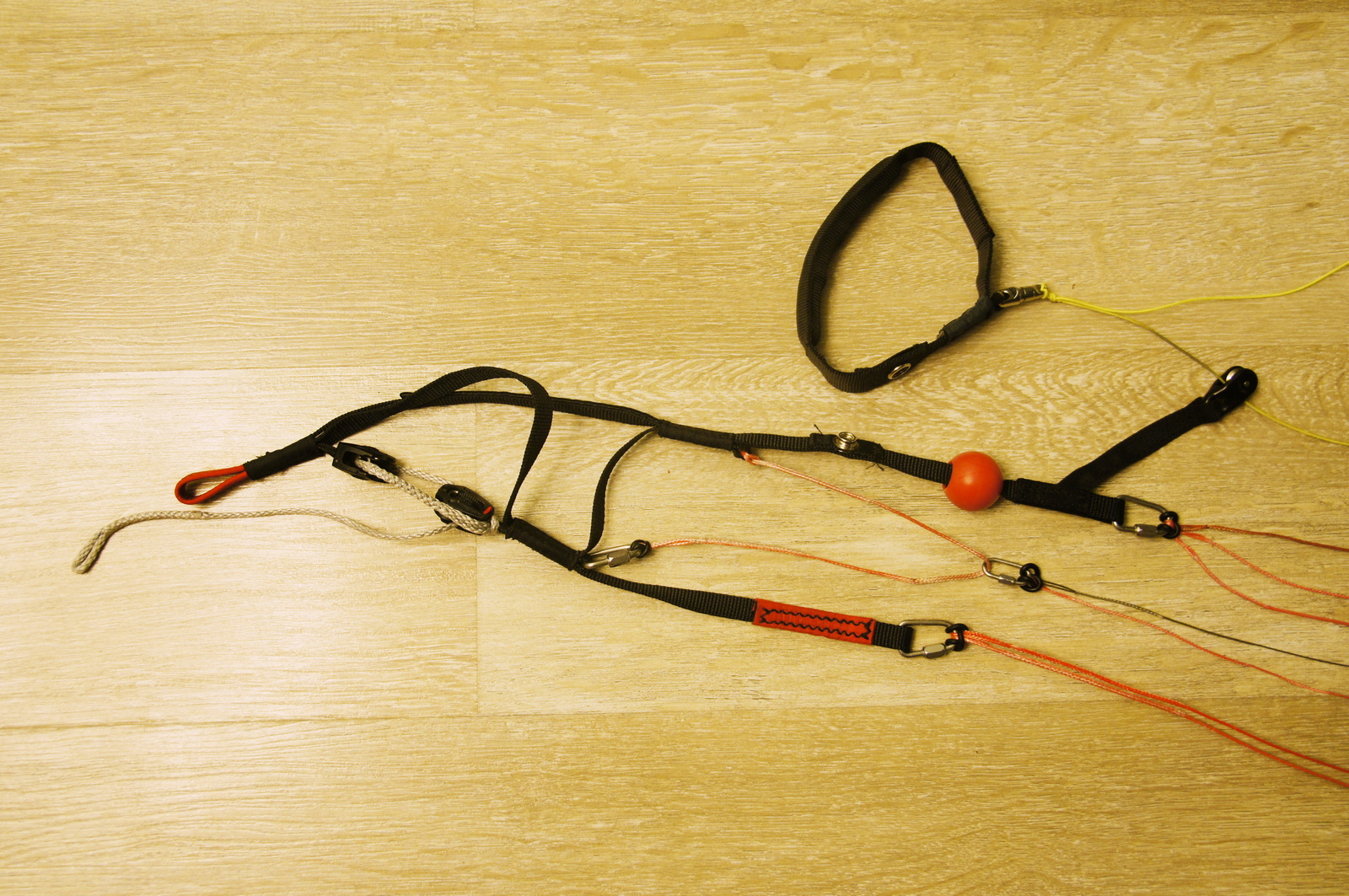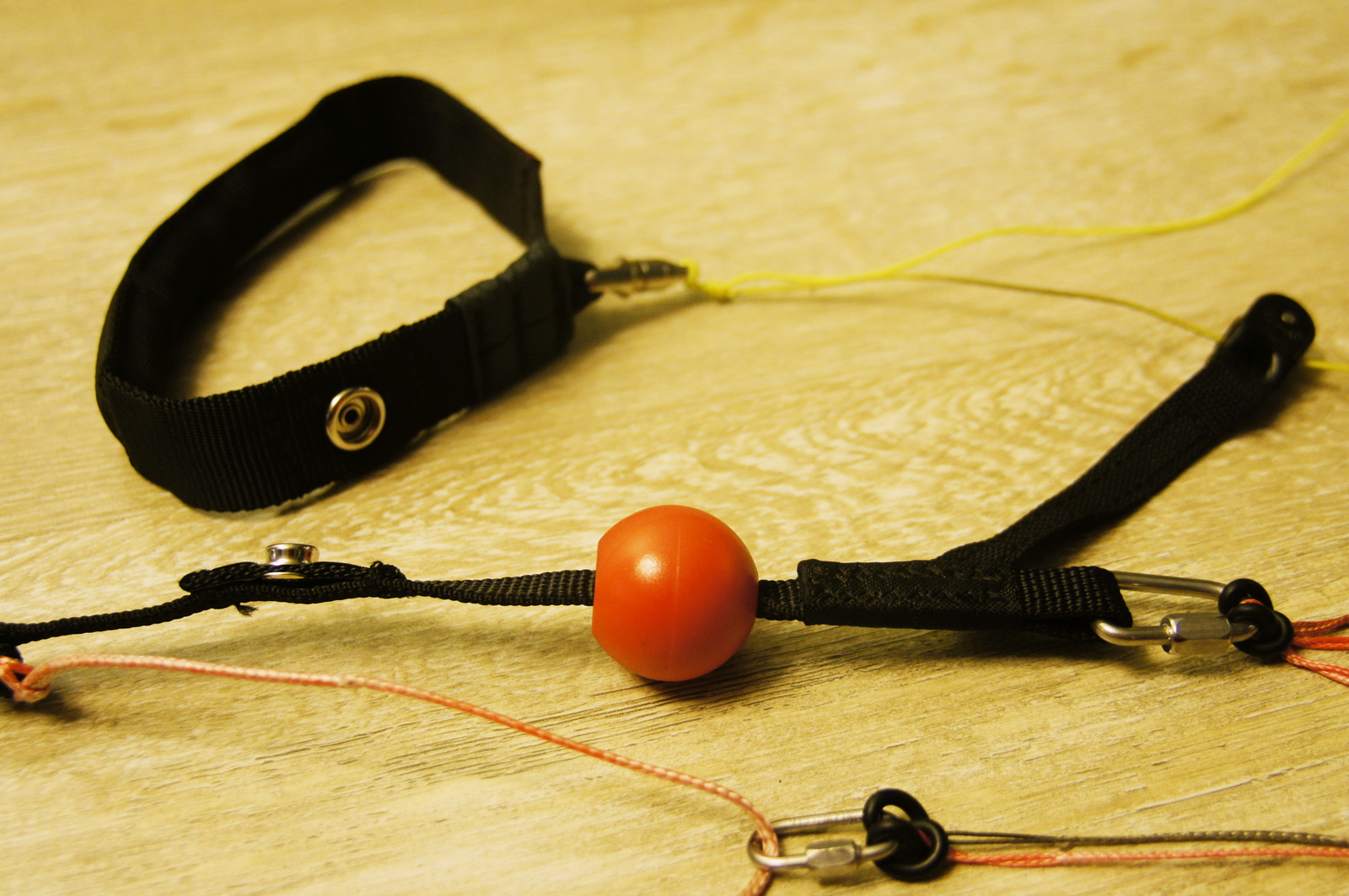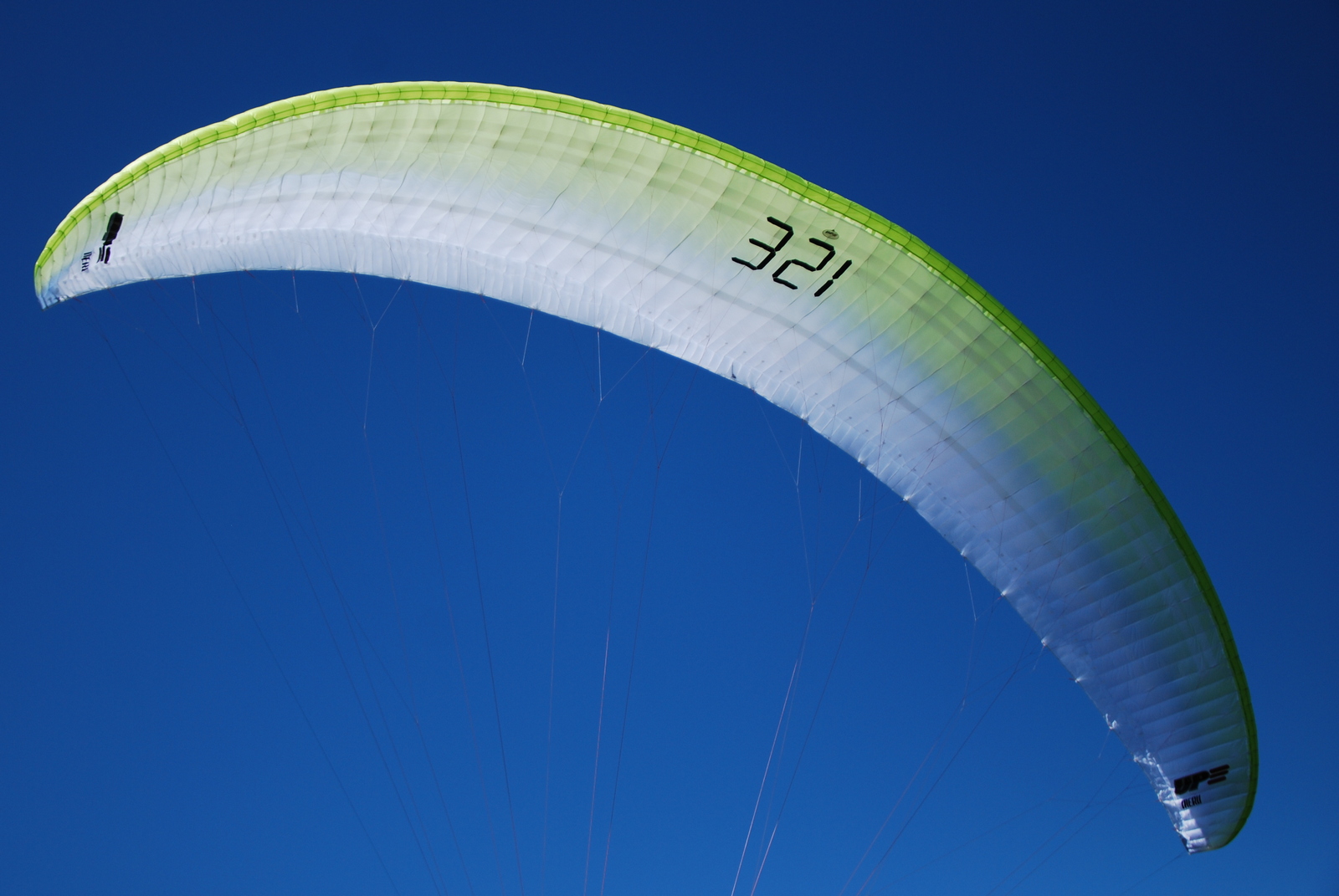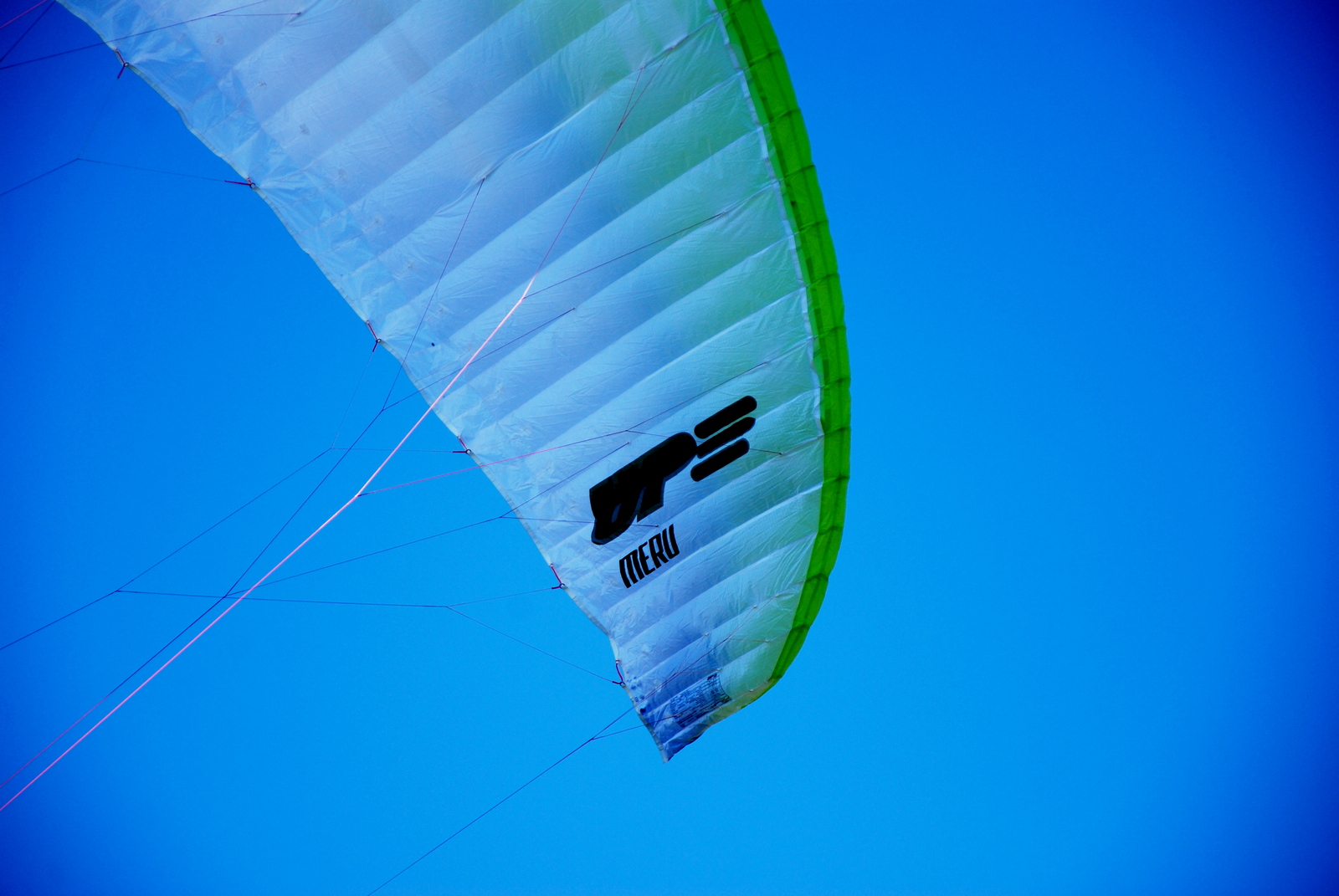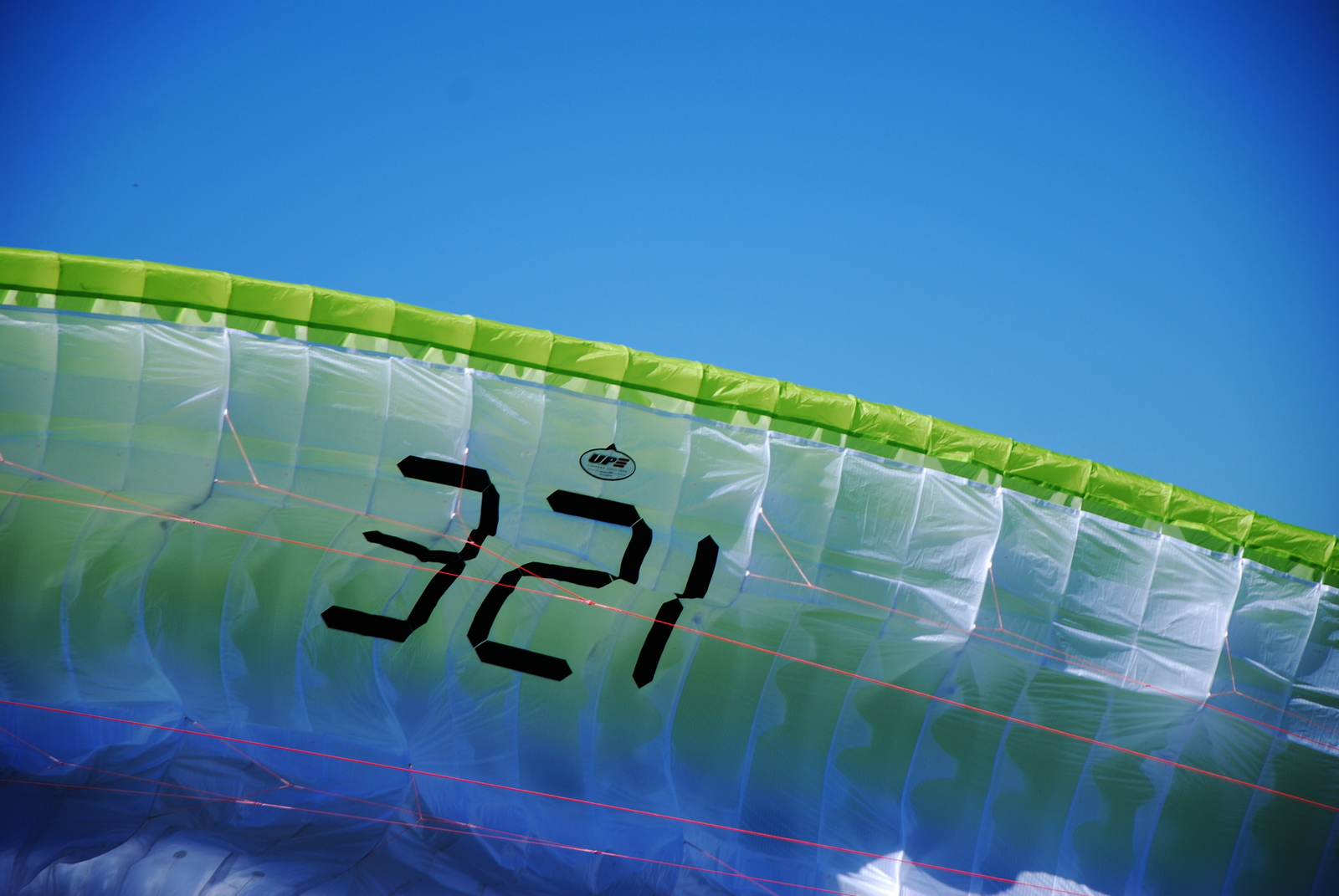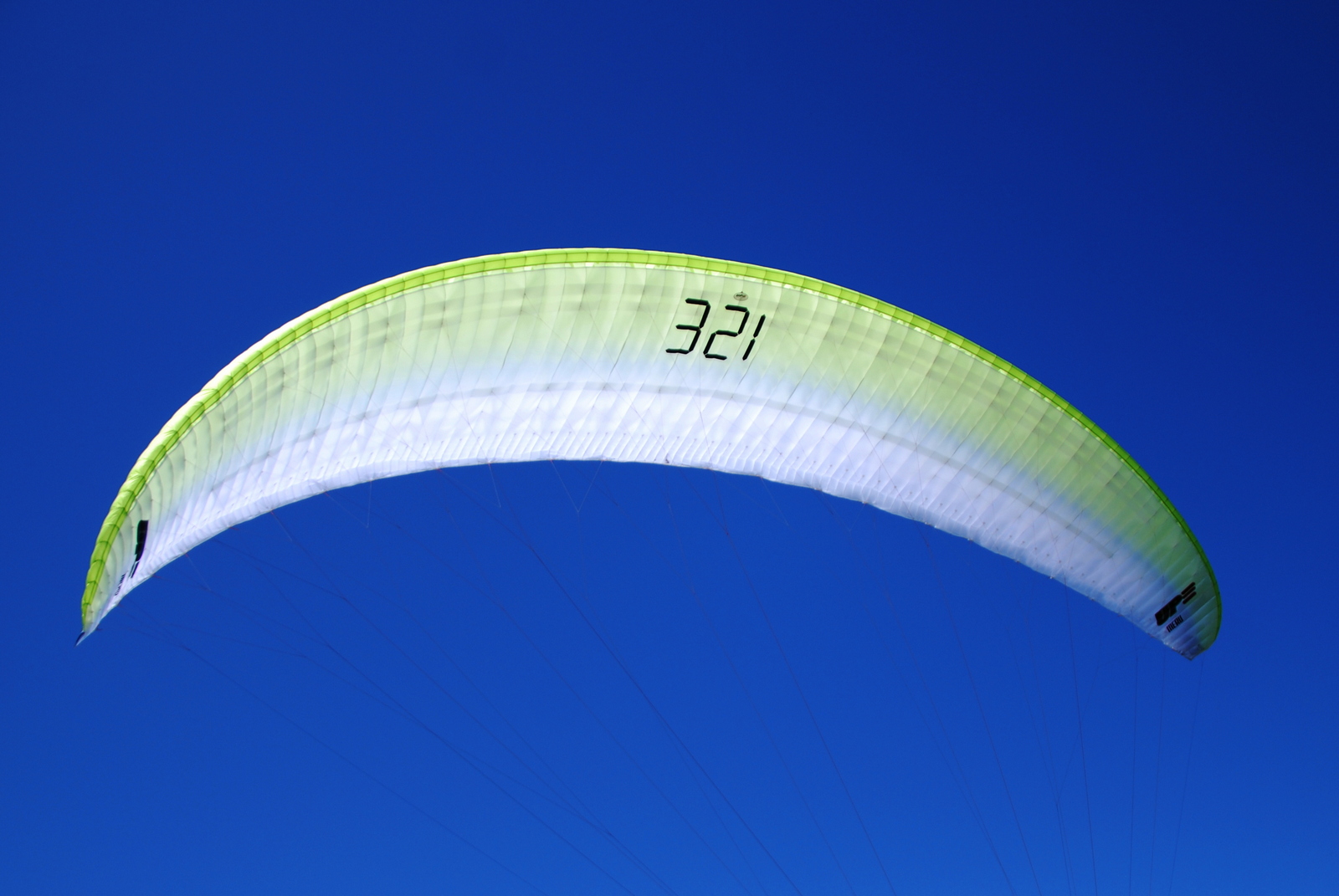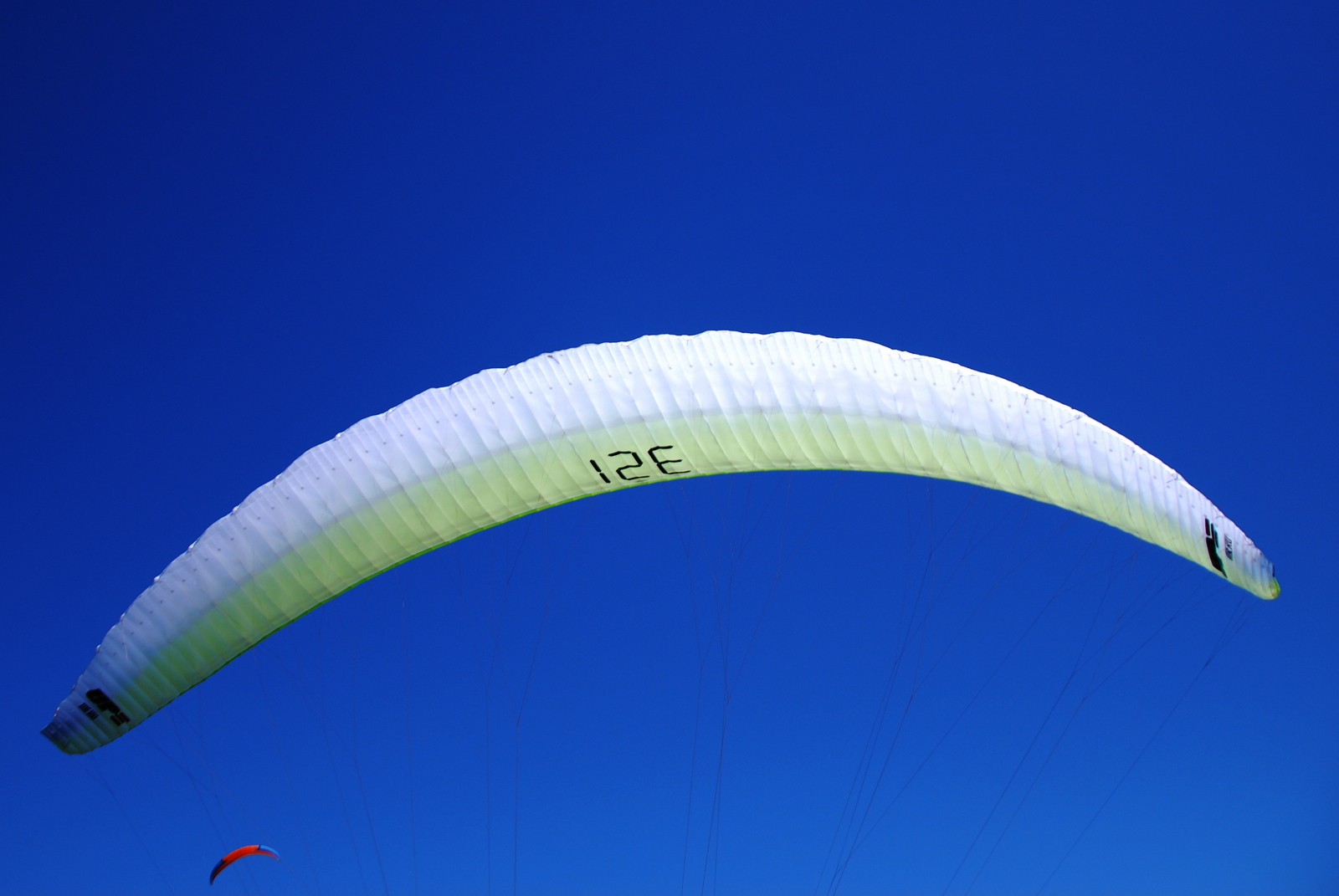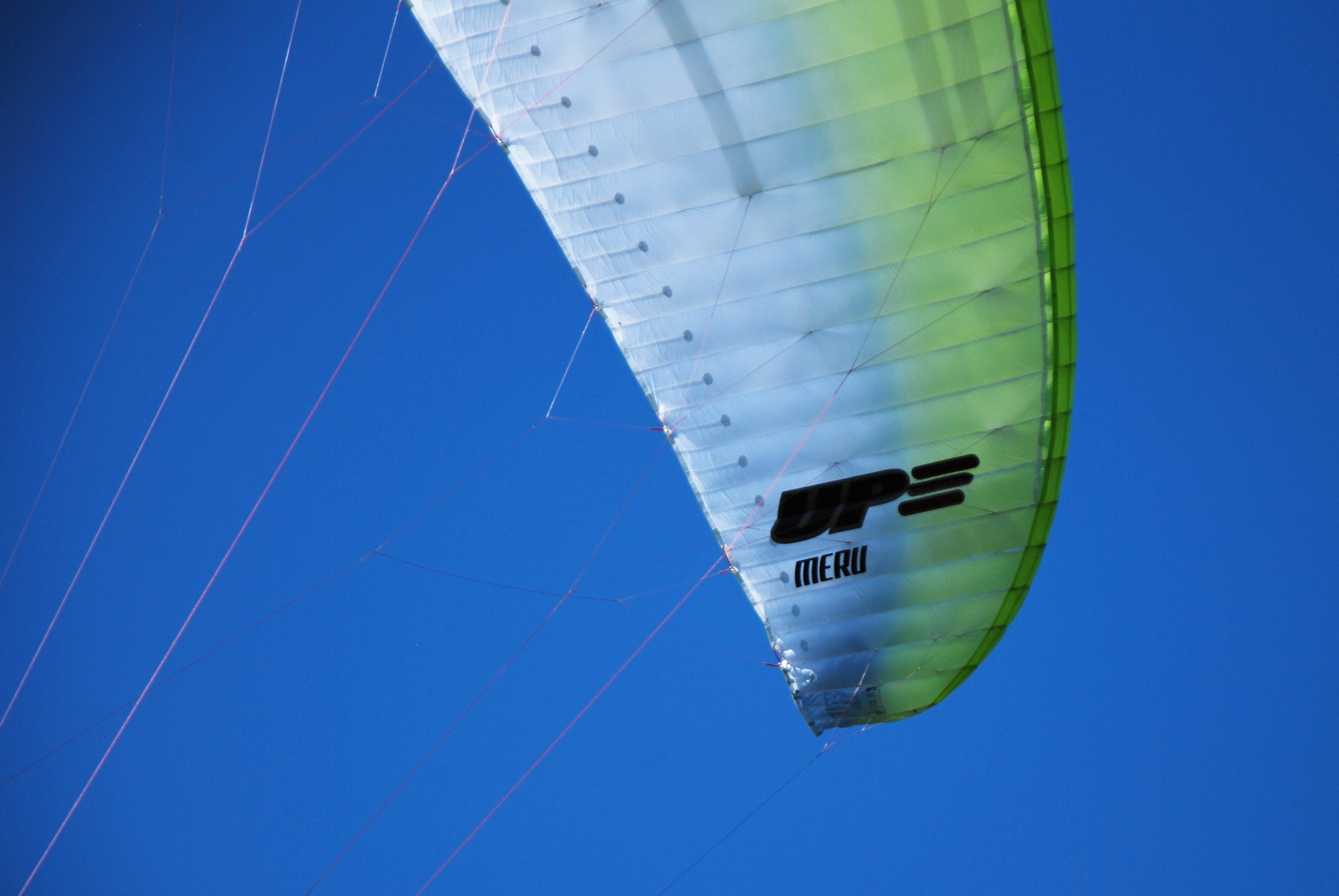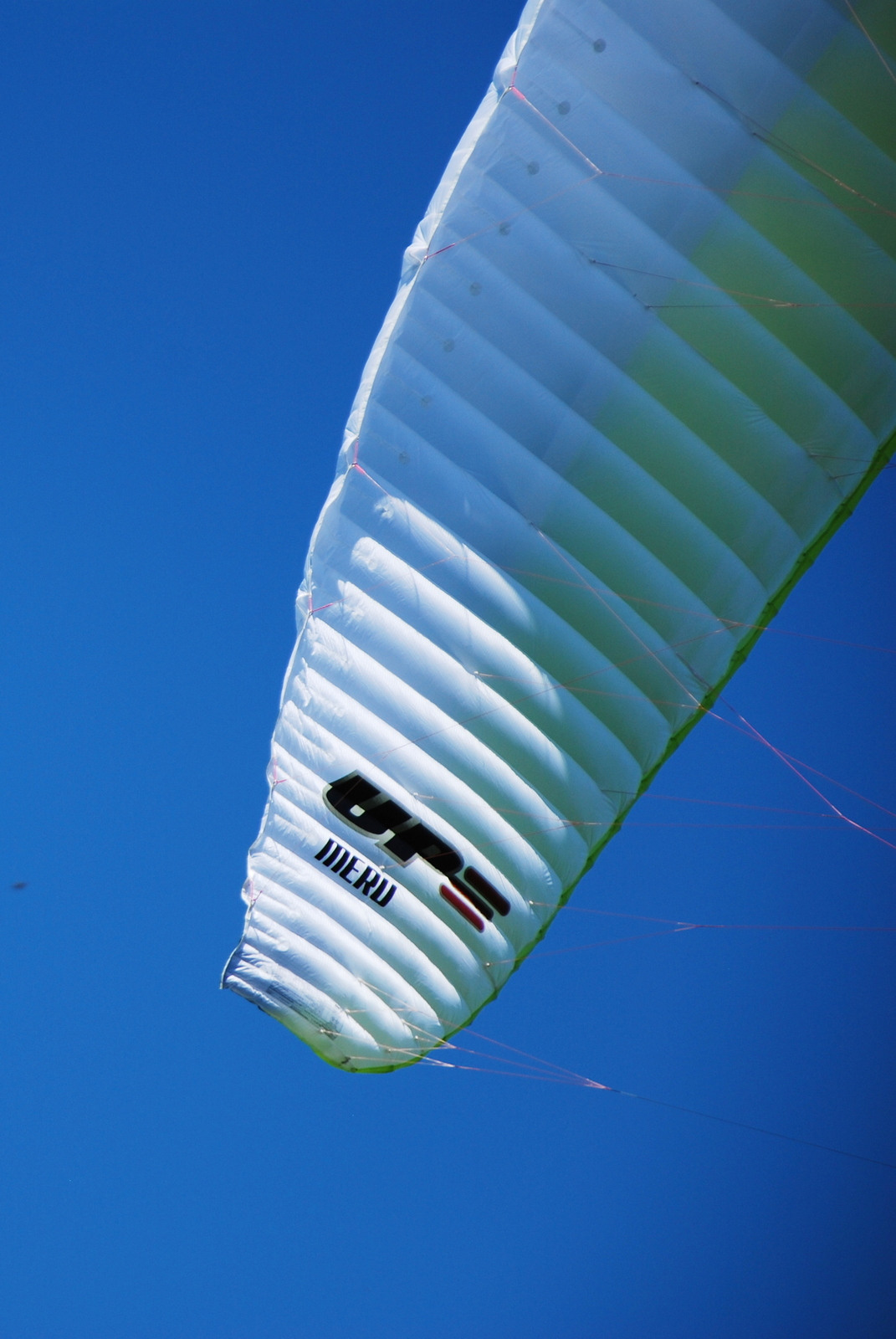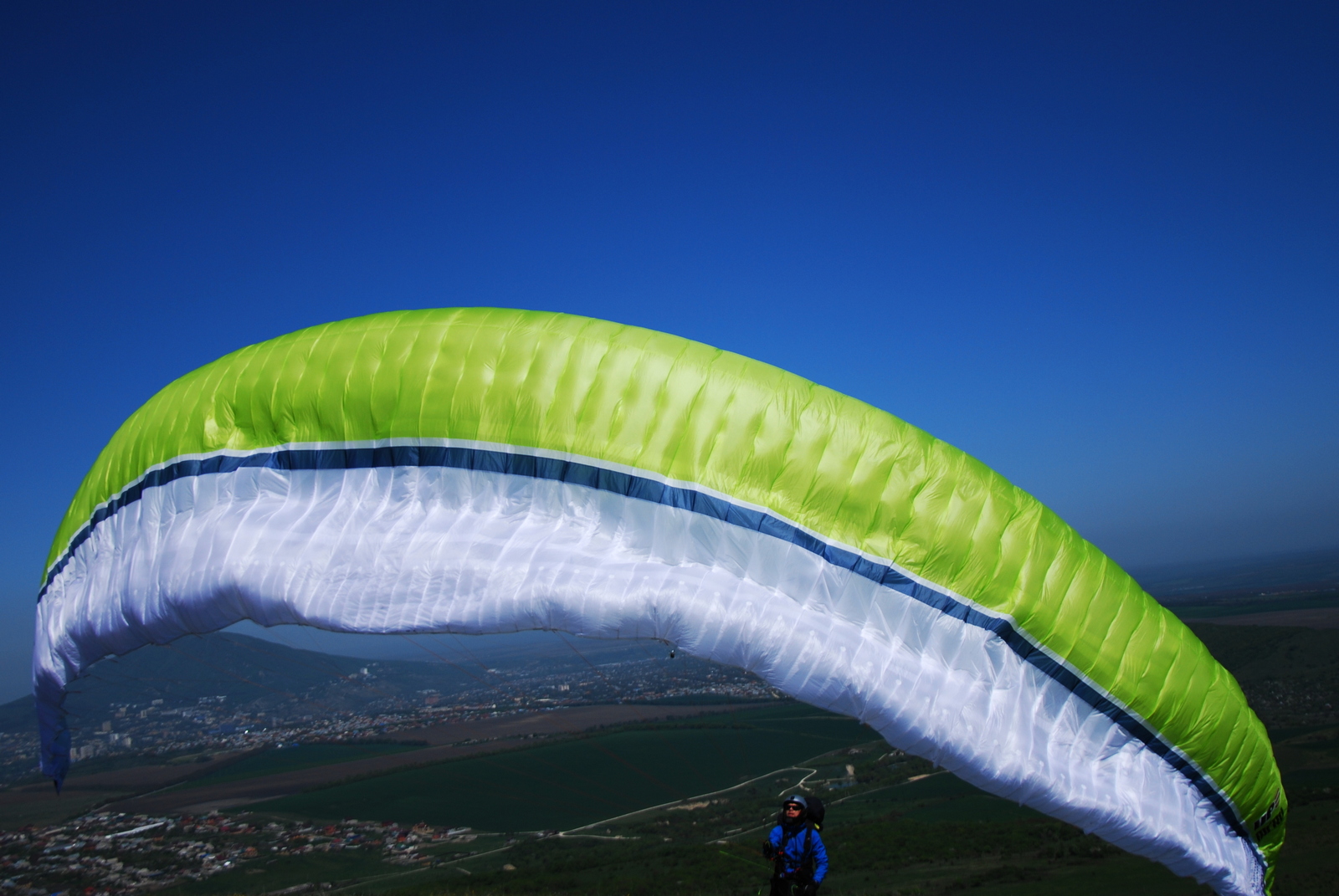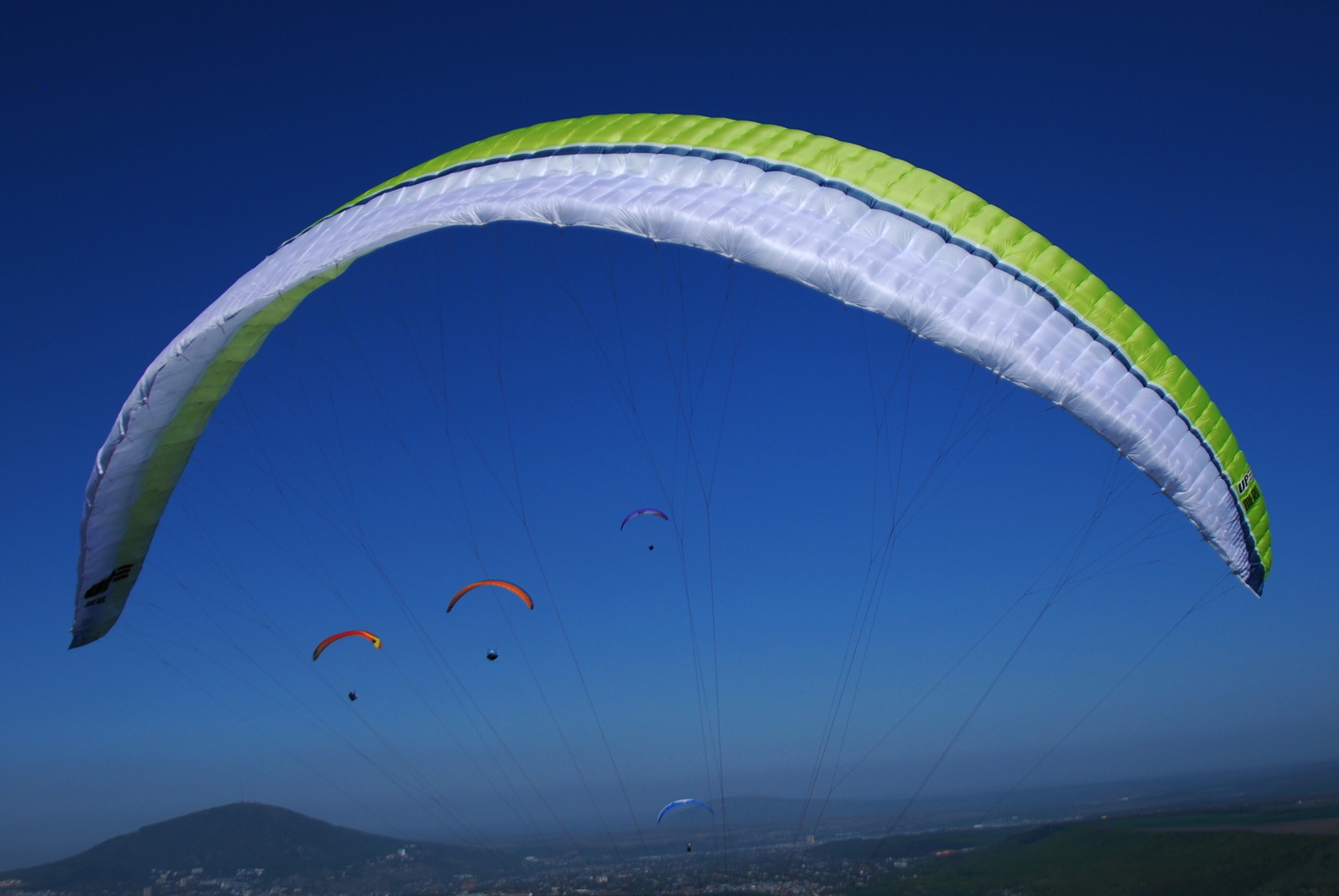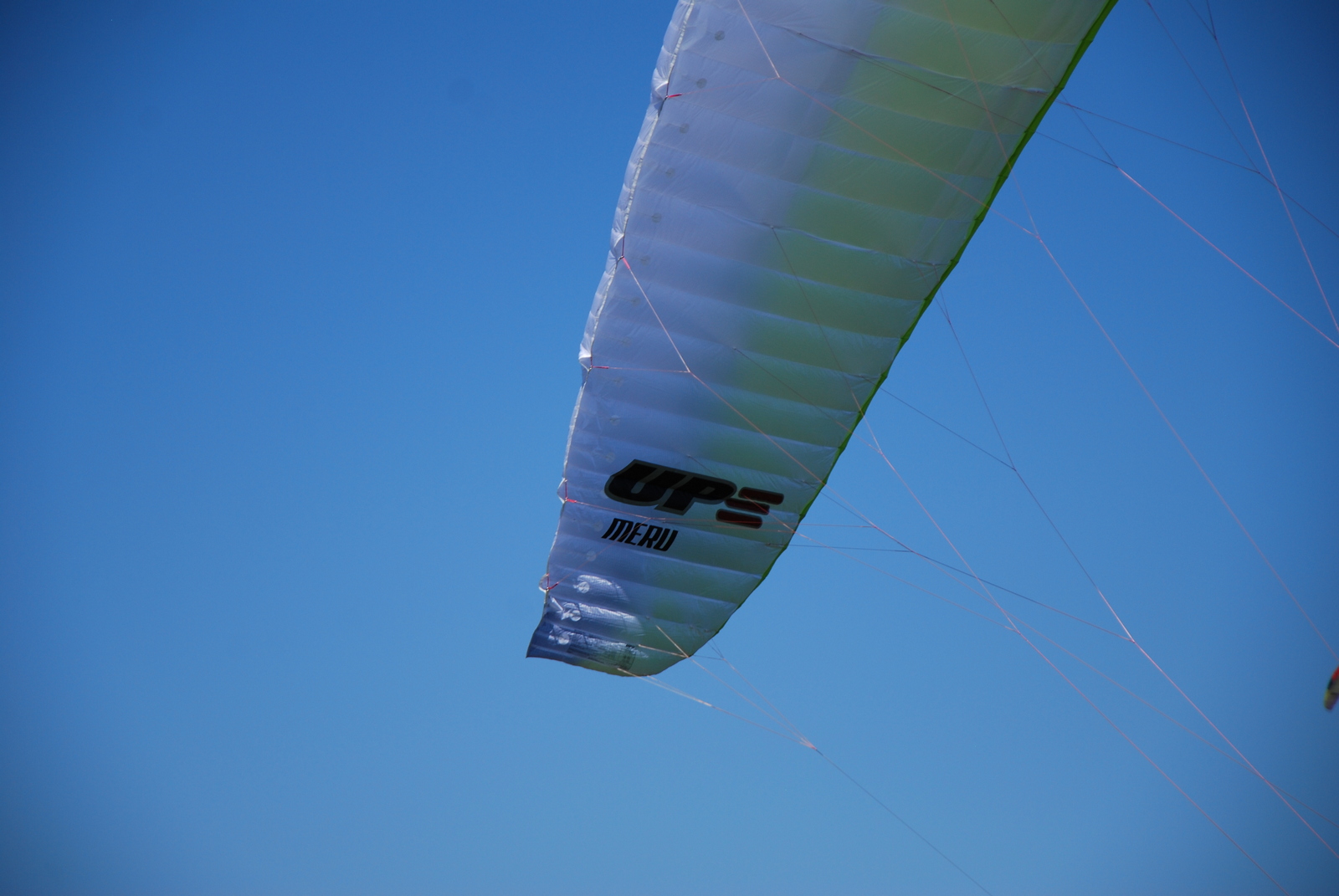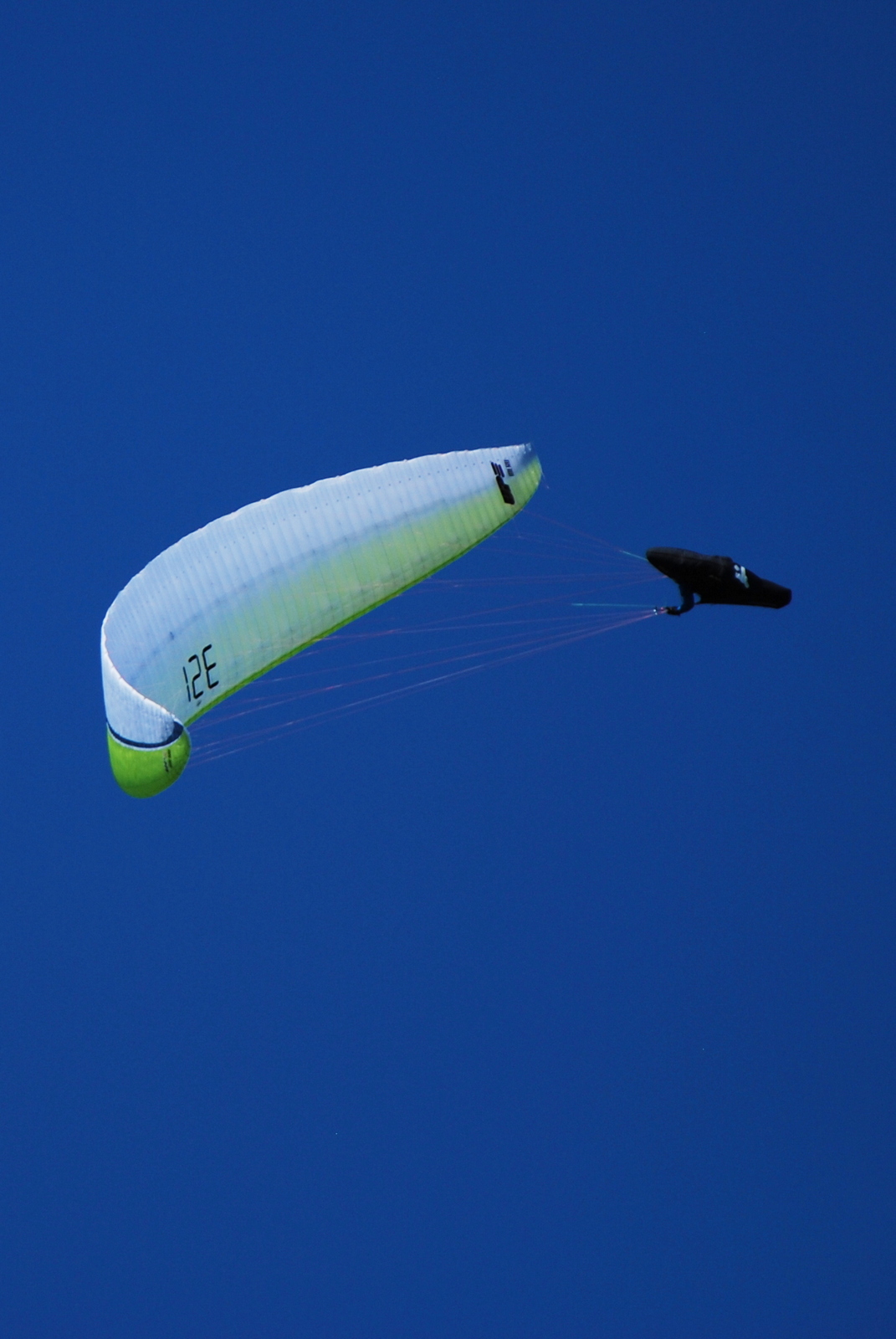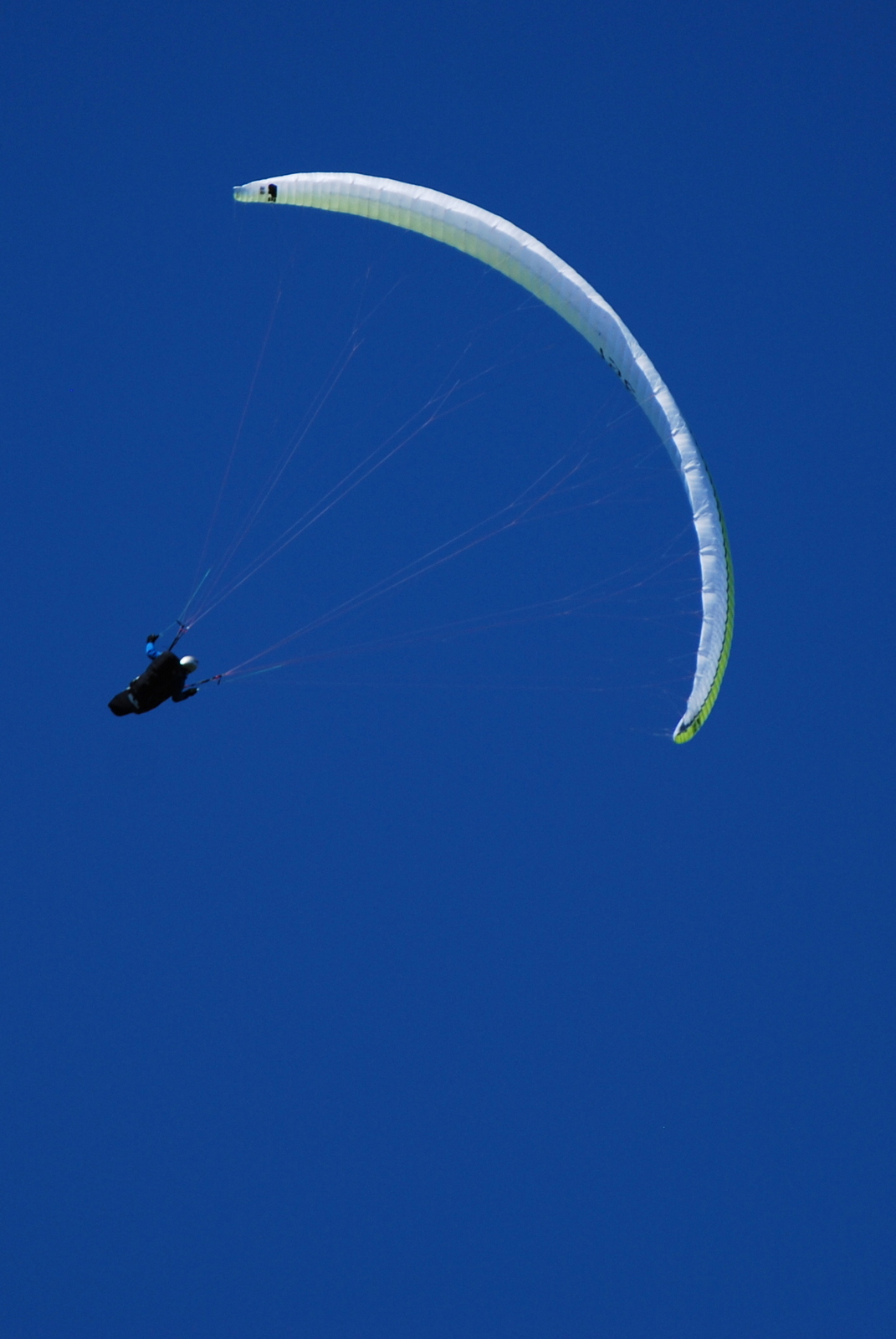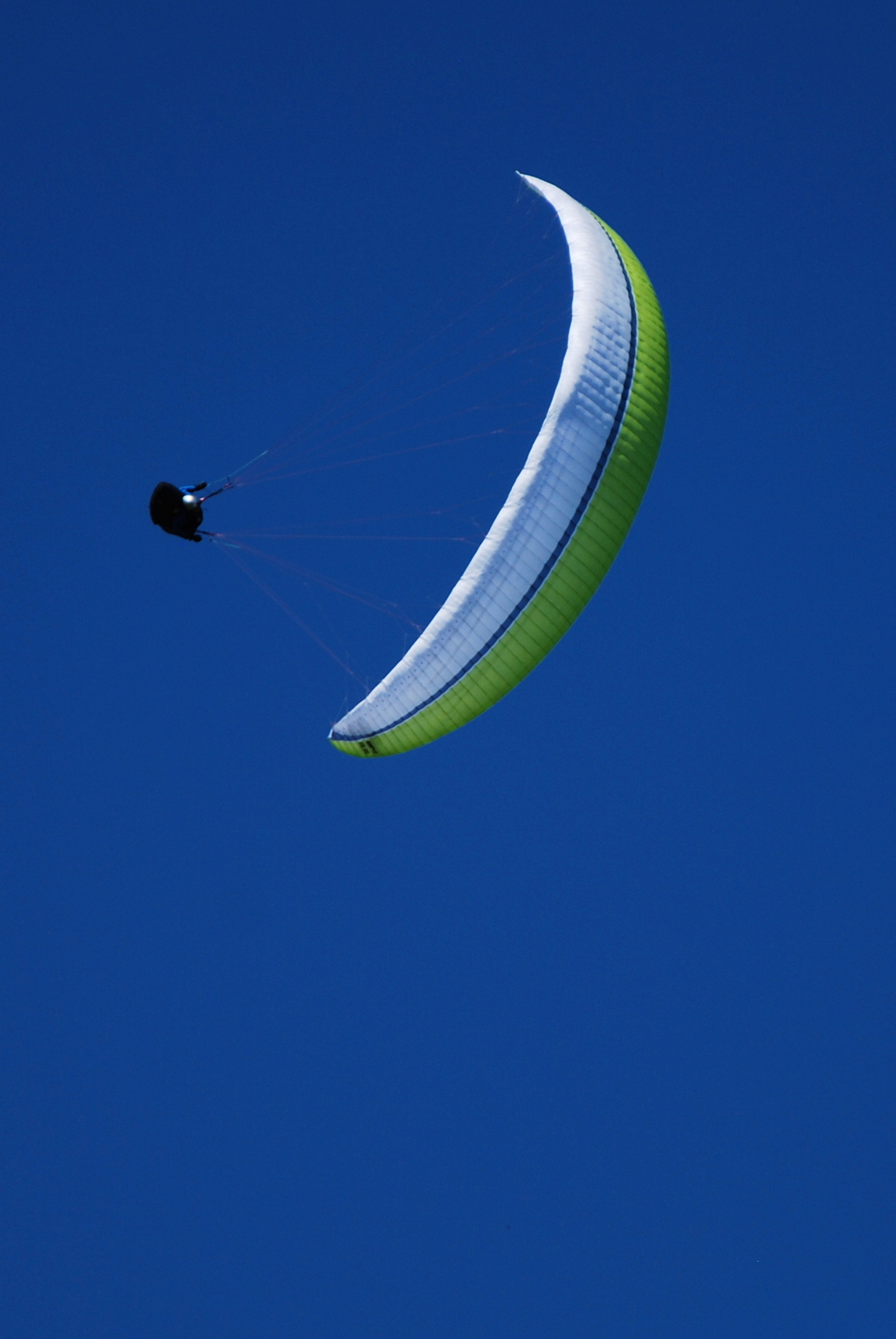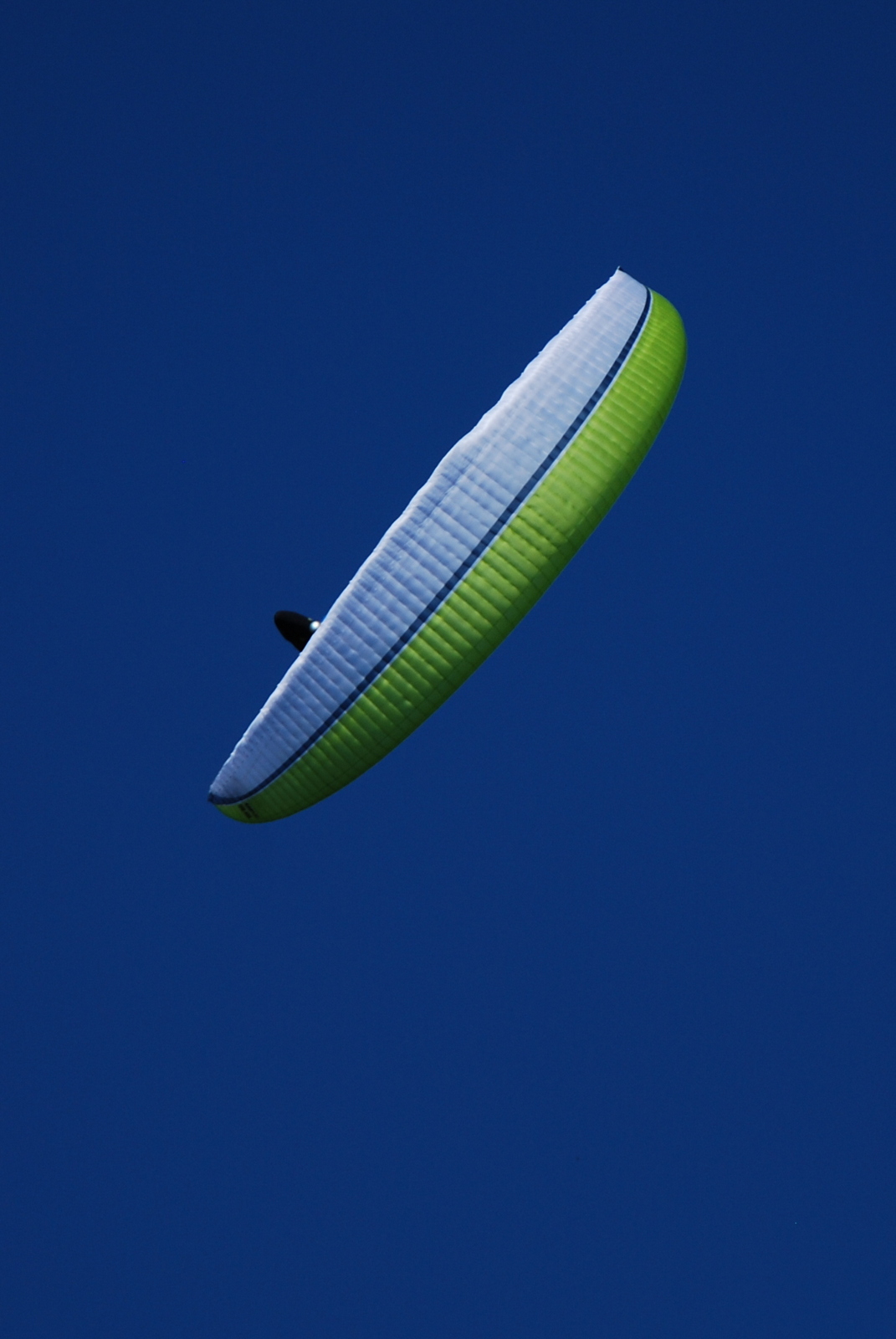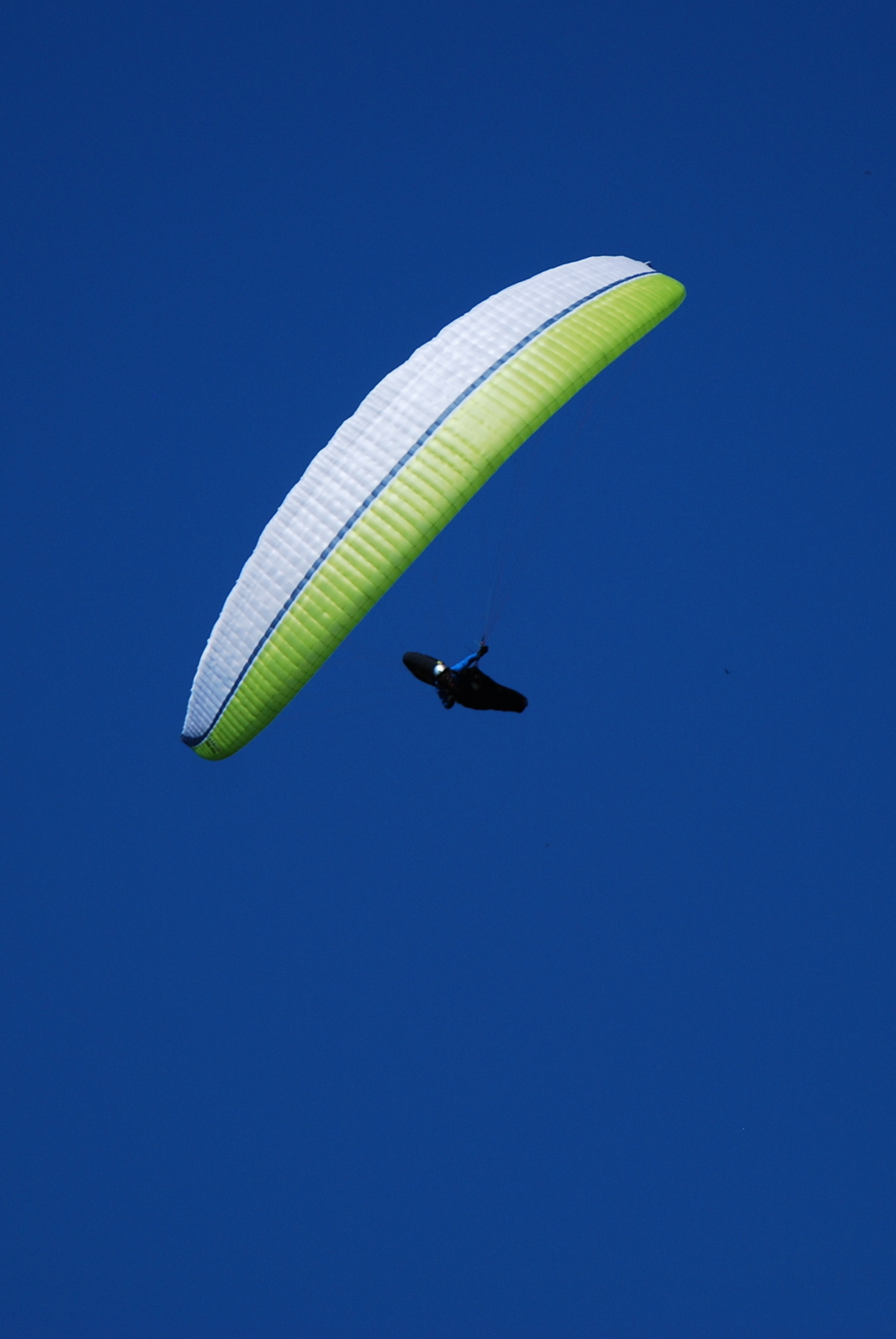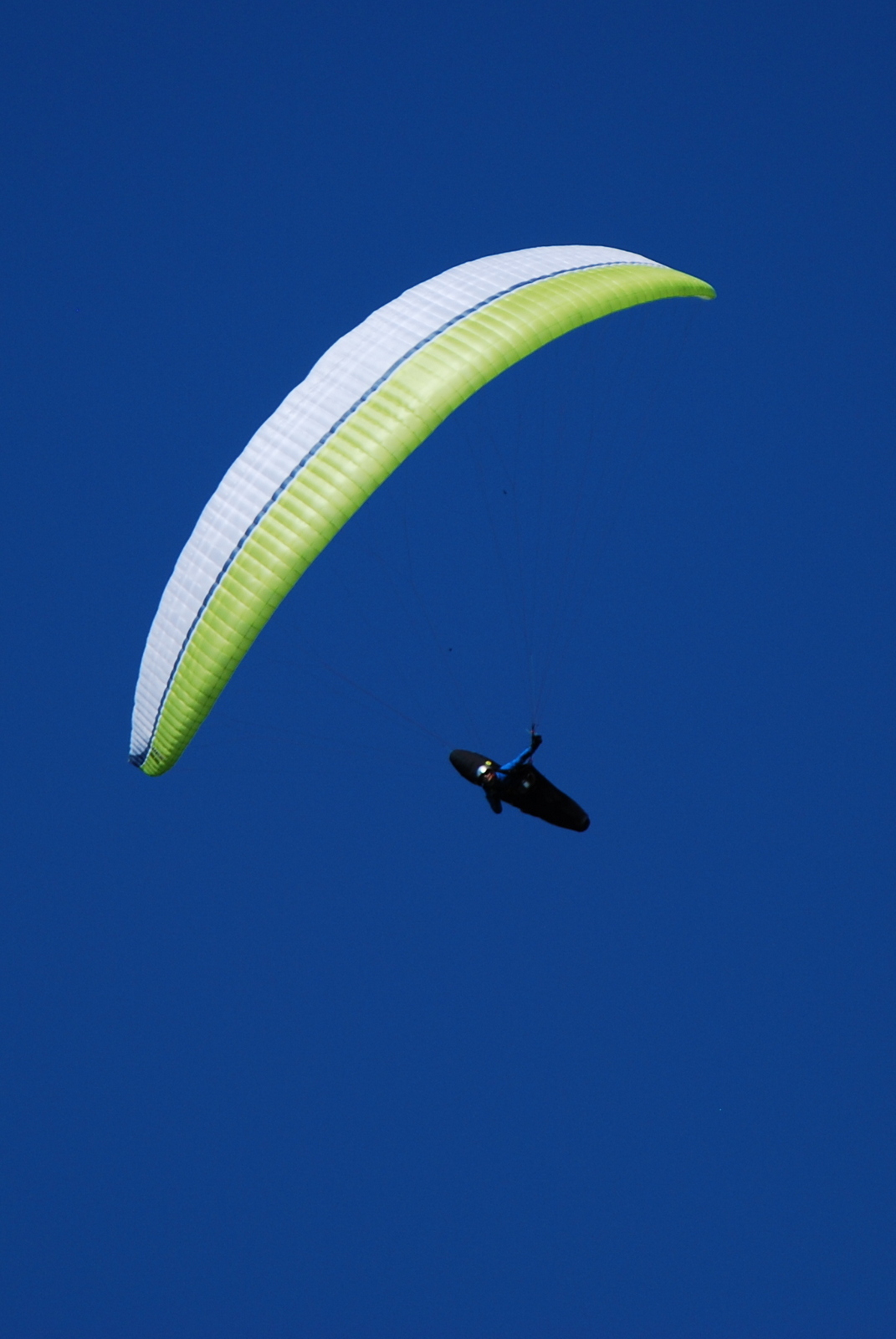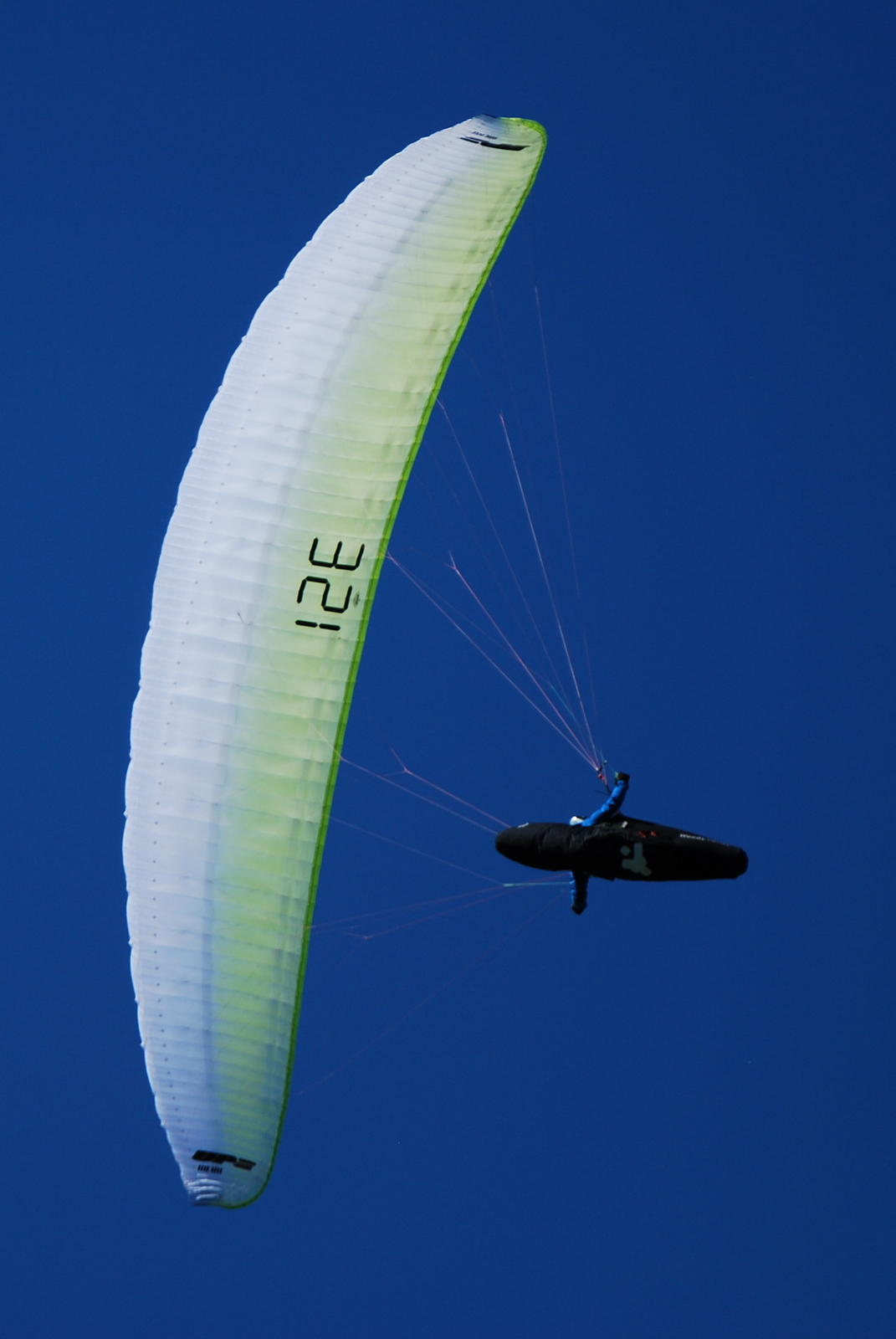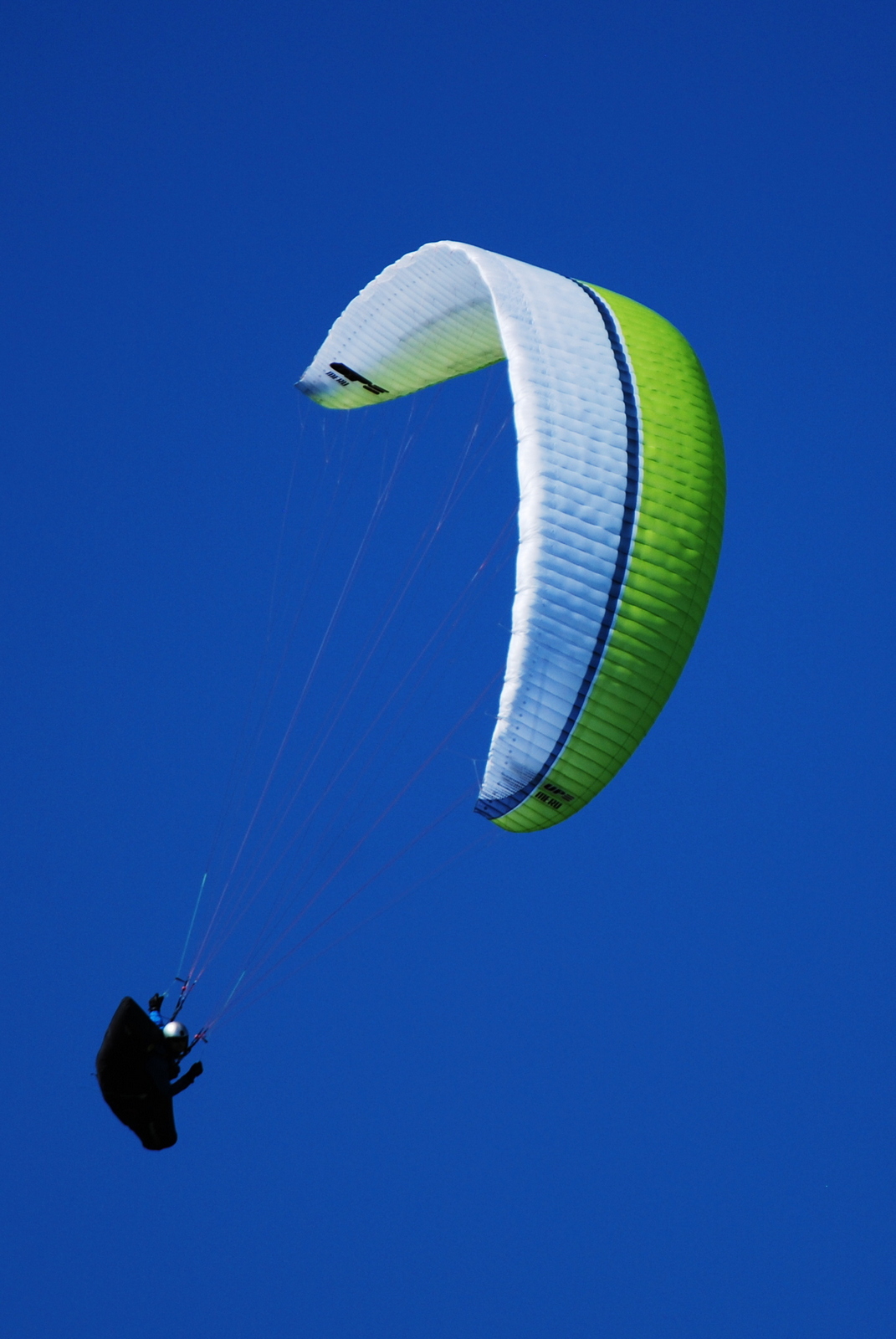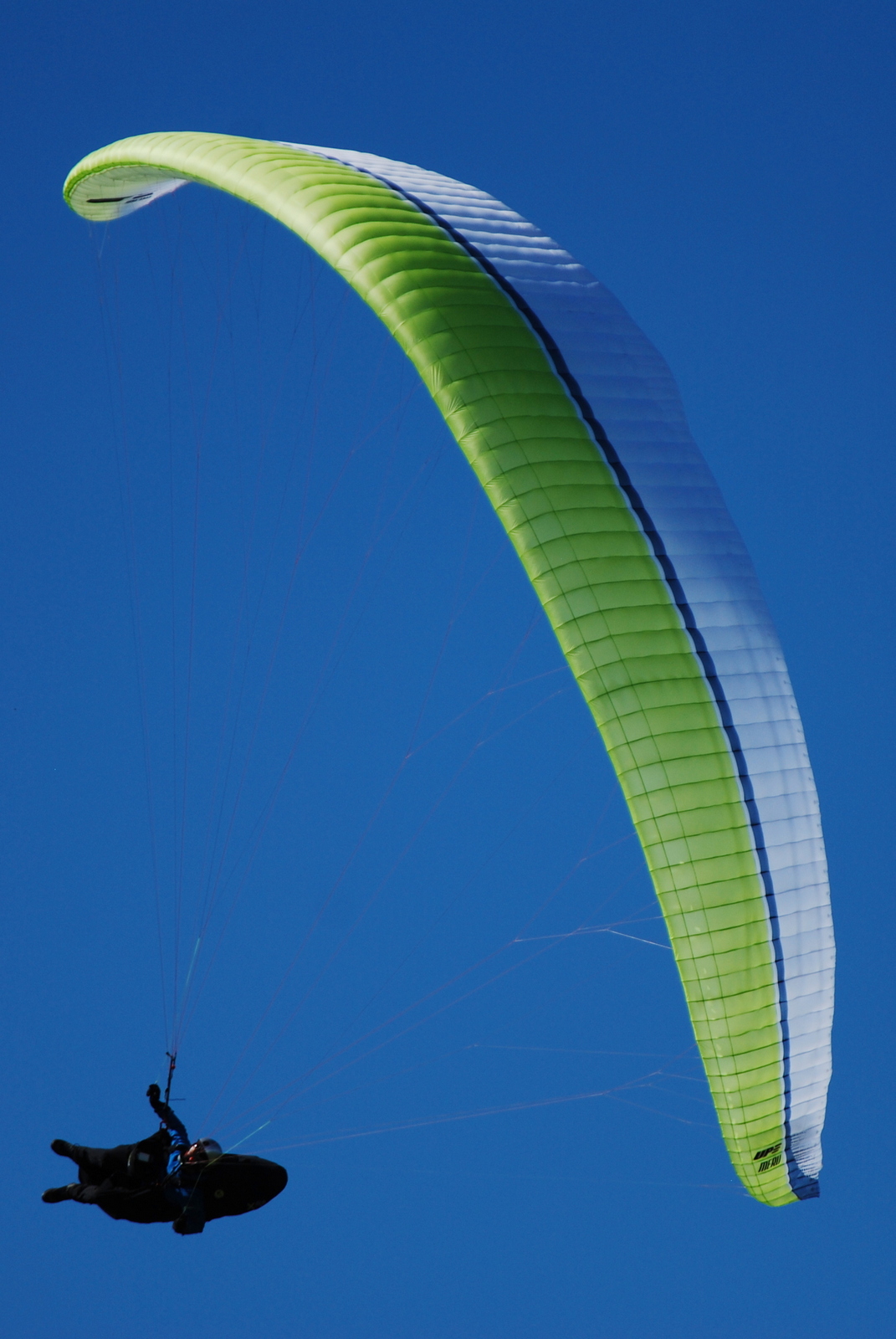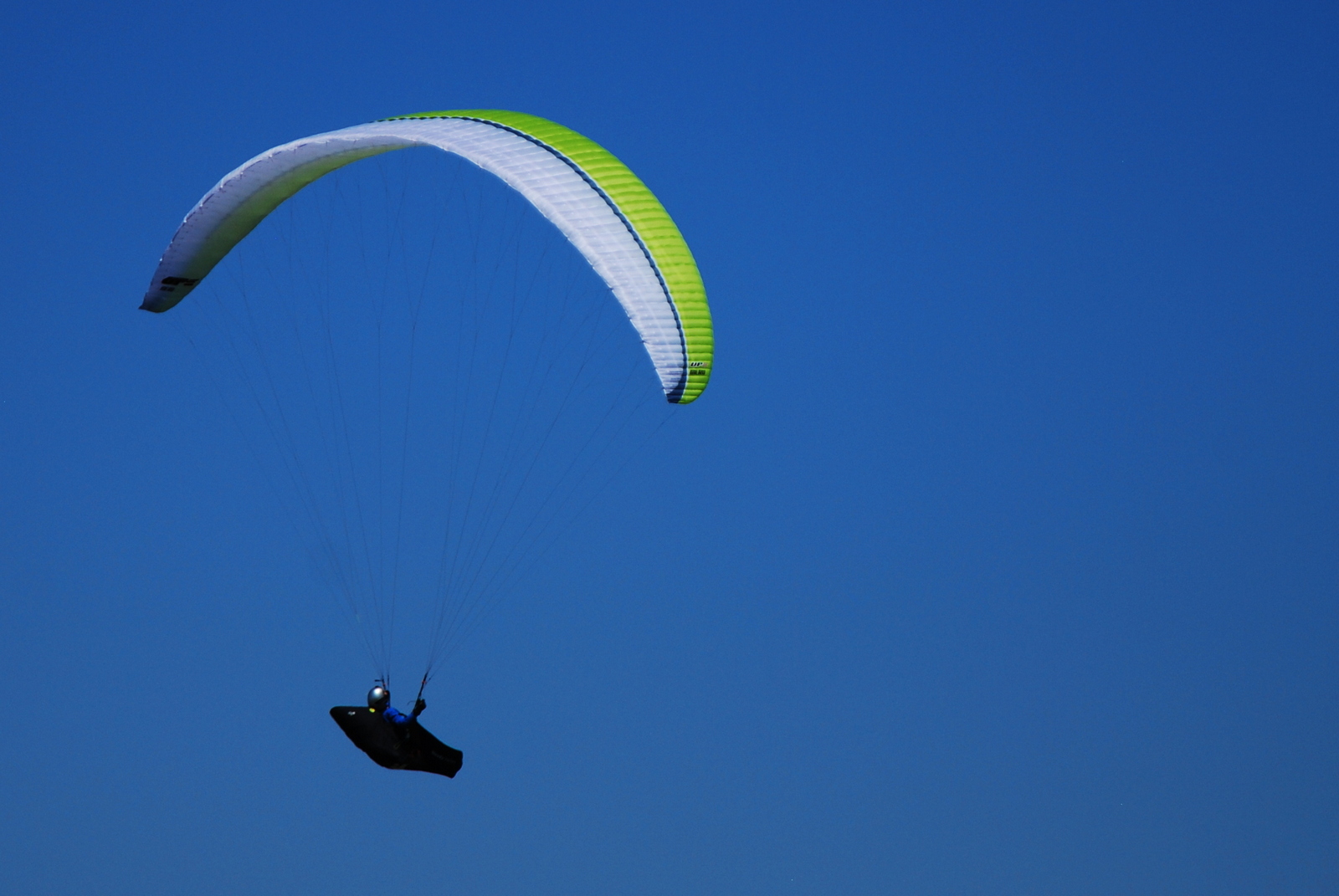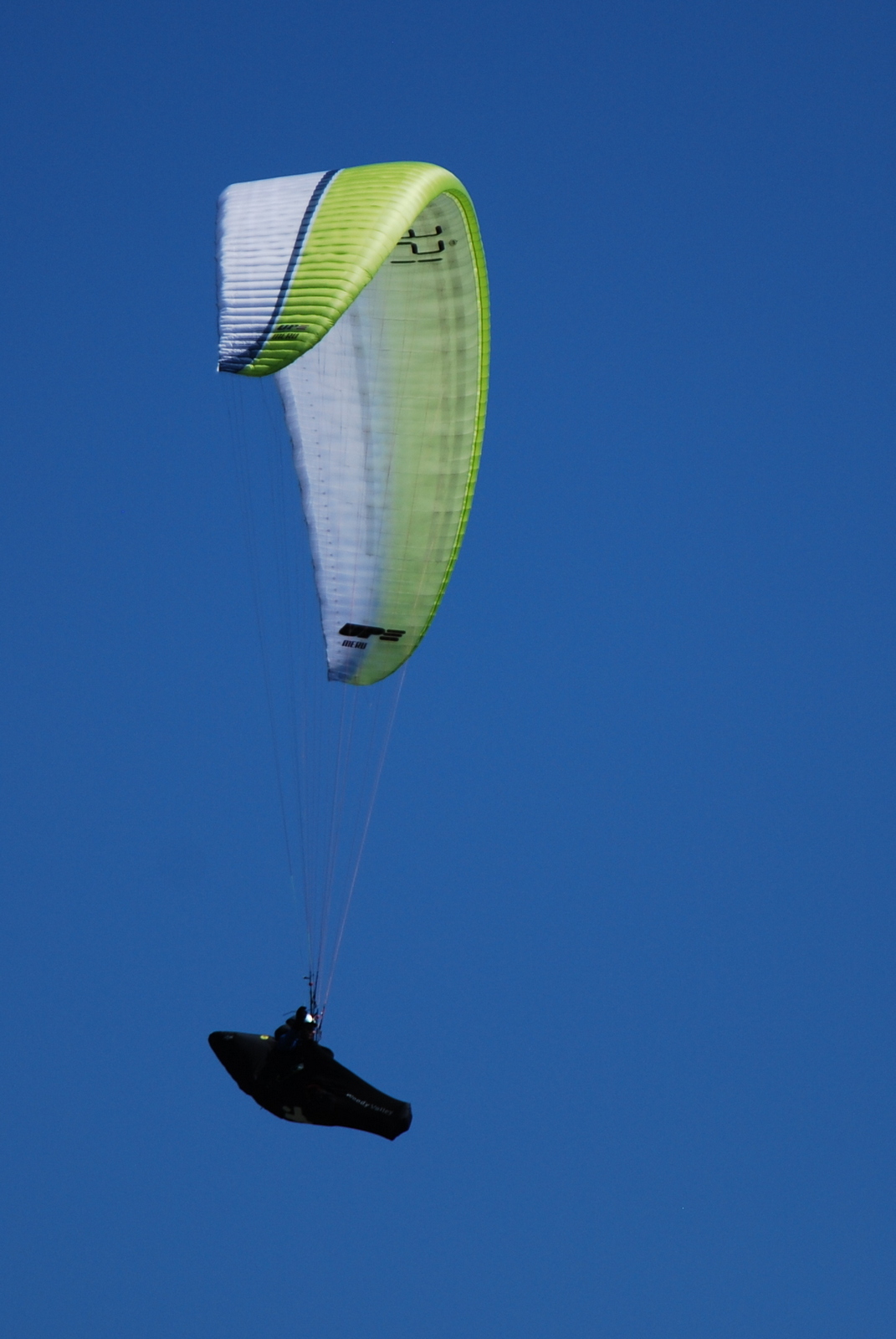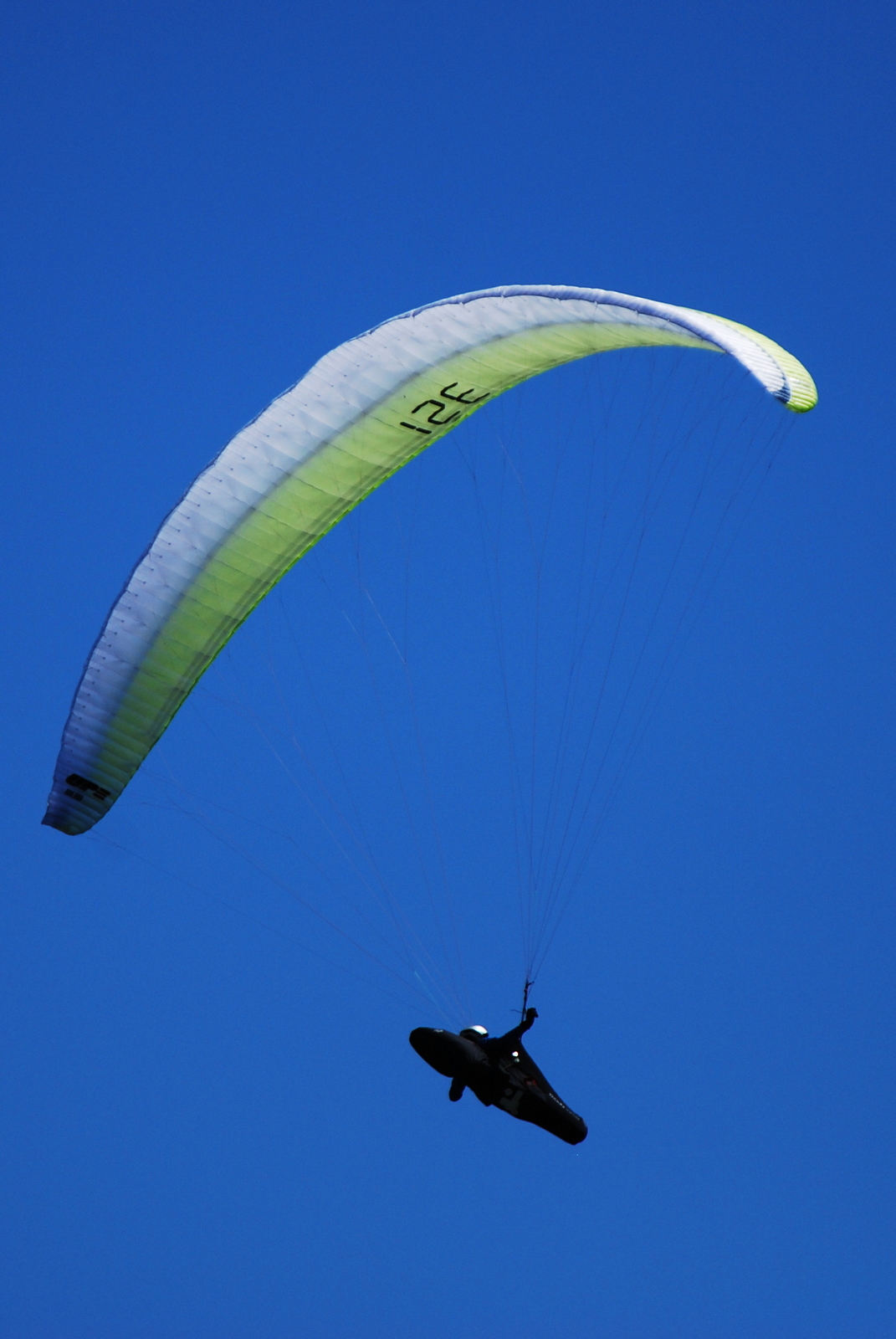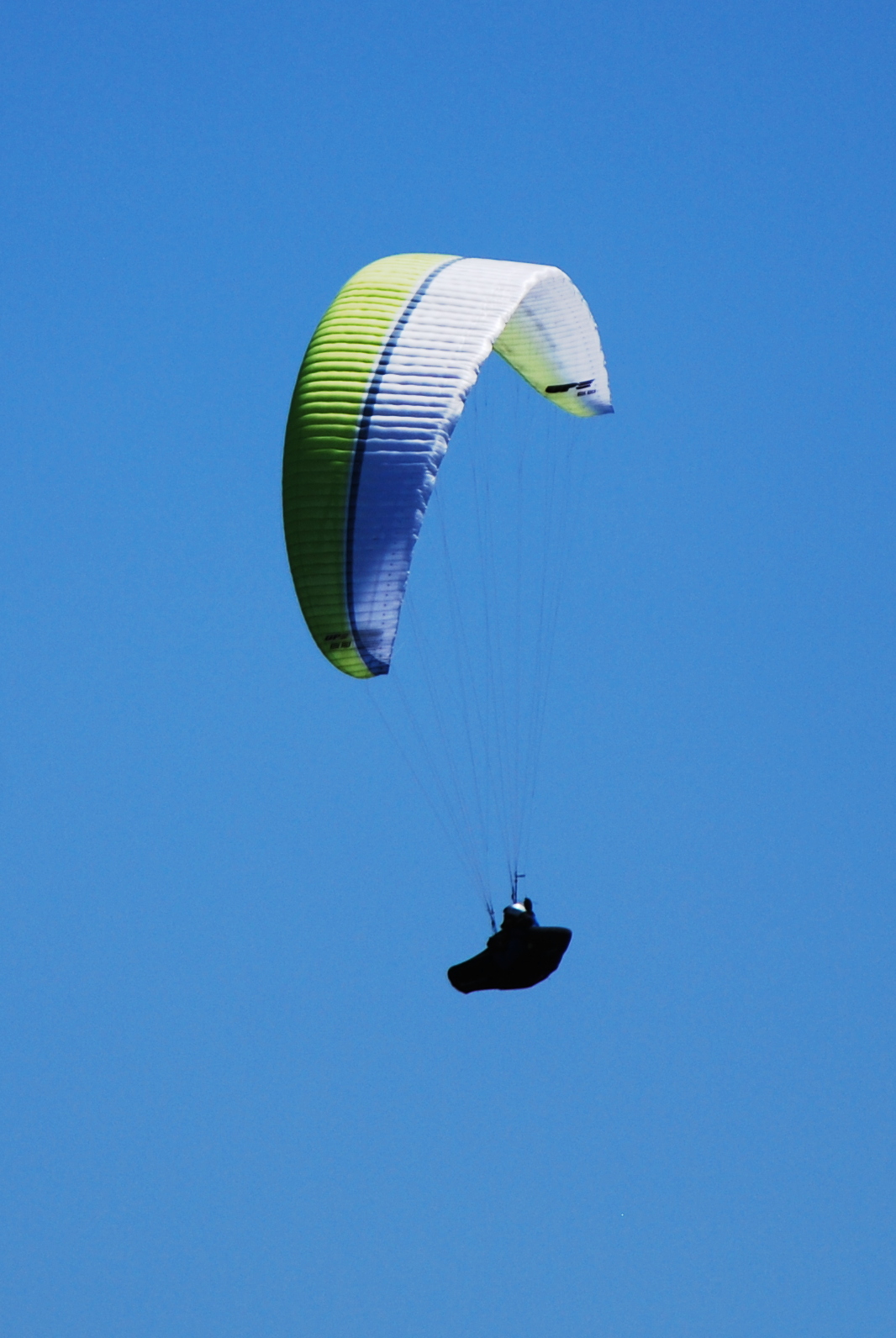Everything you may expect from UP: perfect turn, classical behaviour, decent performance, now in EN D two-liner format!
Construction
Risers
Nice and minimalistic but having everything you may expect from a top EN D glider. The narrow webbing, high quality speed system pulleys, big red balls on rear risers for controlling the glider in accelerated flight (a bit less convenient than handles but not tangling with lines), big and convenient brake handles with swivels. The manufacturing quality is typical for UP: nothing to complain. The only (very minor) drawback is the absence of magnets for brake handles: they are connected to rear risers by buttons which, at least at my point of view, are less practical.
Canopy
The first thing you will discover even before getting the Meru out of its concertina bag are the long plastic rods running almost 100% of chord. This makes Meru relatively delicate in storing and transporting: at least you need the cylindric "ozone-style" pillow provided with the wing, but the better way is to wrap the Meru around your harness.
Okay, let's take a look at the wing. The manufacturing quality is perfect, it's difficult to find an imperfection. The leading edge has a trendy 3d-shaping which smoothens the surface of this very important part of the wing. The shark nose is also well present. The wing shape is very "Trango Xrace-y", but there are some important differences: more cells, very narrow intakes, mini-ribs at trailing edge and a totally new internal structure needed to distribute the loading from only 2 rows of lines. There are also smaller details that differ Meru from X-Race but in general it's a pureblooded UP glider with typical UP look and feel.
Lines
A carefully chosen blend of materials which is however classical for 2-liners: a mix of Dyneema and Aramid in upper and middle cascades and Aramid in lower cascades. Of course all lines are unsheated, and Dyneema lines have red anti-UV coating. Technically Meru is a "2.5-liner" (like some of Niviuk 2-liners): the upper A cascades split in chord giving a steeper load distribution for the price of very minor increase of drag.
Takeoff and groundhandling
Groundhandling
One of the simplest 2-liners i've ever tried! The groundhandling is however a bit specific due to long plastic rods. In moderate to strong wind conditions the trailing edge may rise and turn upside down blocking the air intakes and preventing the wing from inflating. But once you get familiar with this effect the ground handling becomes a child play. It's better to initiate the raise by a short body impluse and to accompany the rise with very moderate pull of A-risers to bring the glider overhead in a smooth and calm manner. The recently tested XChord has less tendency to shoot forward than Meru, but still no problem, you need to apply a minimal amount of brakes to stop the glider overhead.
Another positive thing about Meru is its amazinng capability to pardon the pilot errors during groundhandling. You don't need to be very fast and very precise, the glider always leaves some room for possible pilot errors which are easy to correct. Once overhead, Meru is very stable and demands very moderate pilot input to stay ready for takeoff. The "cobra" launch and touching the ground with one ear are also amazingly simple, mainly due to hight efficiency of brakes and weight shift. It's easier than doing so with Niviuk Icepeak 6 and 7 Pro. As to the Zeno, this legendary 2-liner is much more delicate to take off and to ground handle than Meru.
Takeoff
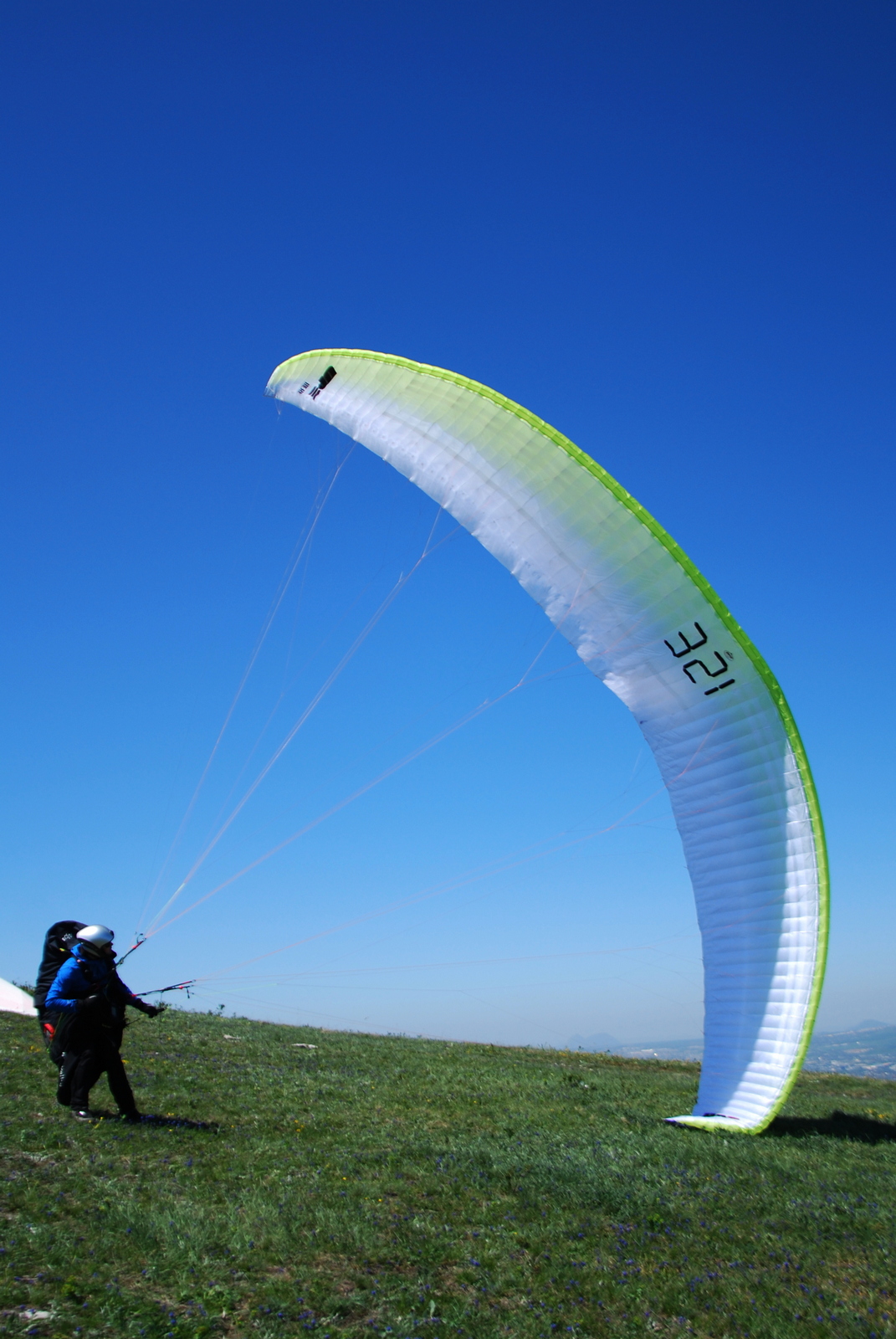
Nothing to complain about! The forward shoot is present but easily controllable by pilot. Even when highly loaded the Meru needs a short run to take off. Taking off in gusty and turbulent conditions as not a problem again. Impressibely easy for a glider of this level!
Flight
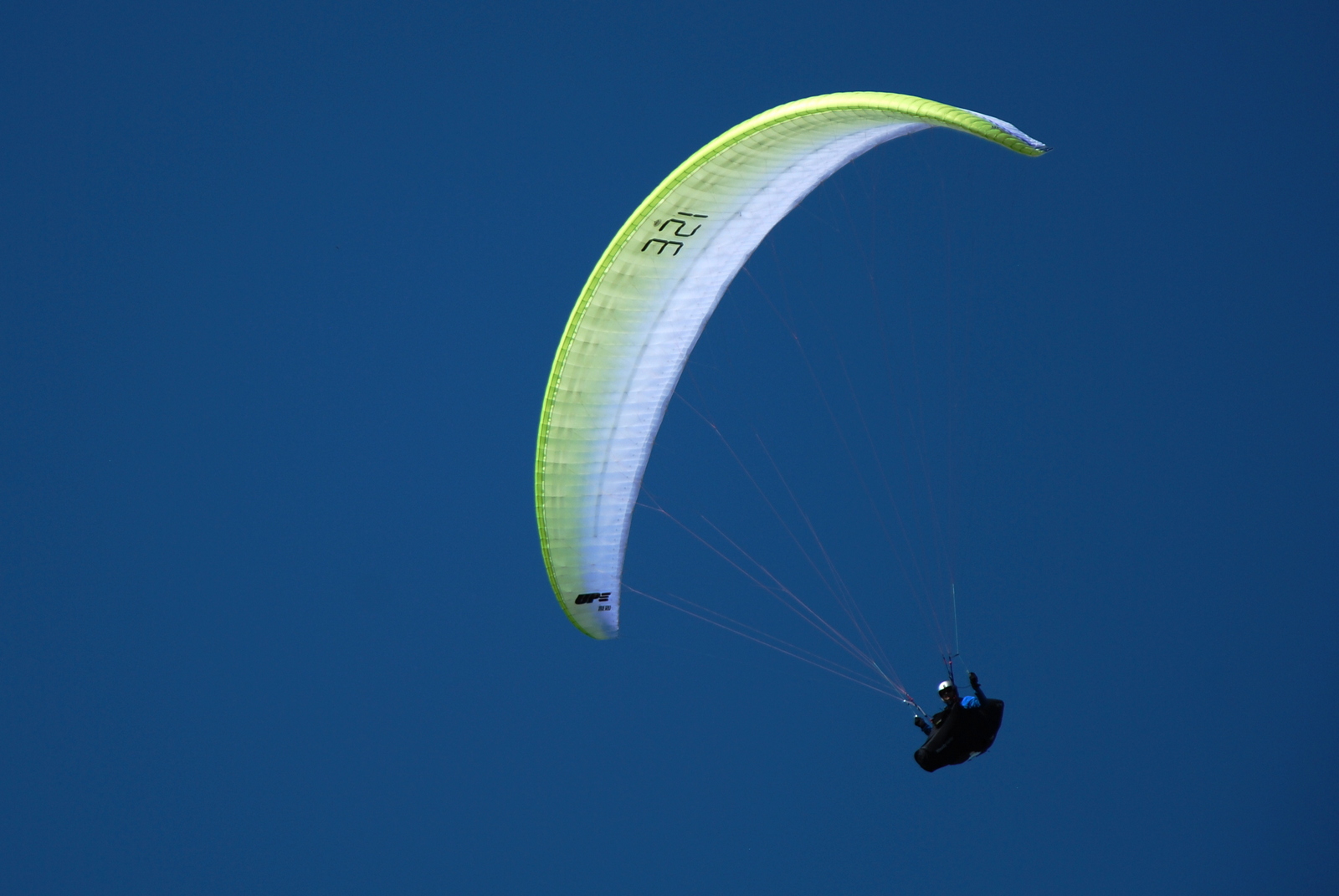
Turn ability
Brakes efficiency
Brakes precision
Weight shift efficiency
Rear risers control efficiency
Wow! For sure Meru is a trend setter in terms of maneuverability and control efficiency in EN D 2-liner class. Meru's turn is amazingly simple to initiate and control, it's like you're flying a high AR 3-liner. There's no slack for brakes which are very efficient from the first centimeters of travel. The glider response to brake input is perfect: fast, sharp and very easy to understand. The brake efficiency is breathtaking: my first wingovers instantly turned into almost-tumblings although i didn't want to go that far! Okay, i was 1-2 kg above the max recommended flight weight at the moment but later i dropped 1-2 kg below and got almost the same reactions, clearly above the market standards. The same thing for weight shift: it's better flying Meru with a calm harness to stay in the limits of reasonable for the reactions to weight shift. Of course there are some transitional processes while entering the turn or changing the bank angle (it's okay for a wing with AR around 7) but they are fast and not distracting the pilot from controlling the turn. With Meru, it's however an easy task. For me, feeling and understanding the Meru was a question of just a couple of thermal spirals. Meru is very efficient while thermalling, mainly due to that perfect turn. You can easily play with the turn radius, still keeping a very reasonable sink rate and thus outperforming almost any glider in the vicinity.
Another nice thing: the rear risers efficiency. Both Trango XC3 and Trango X-Race had some problems with rear risers control in accelerated flight but it's just another story when we switch to Meru. The red balls on the rear risers are very efficient, again among the best in class. Personally i'd prefer the more classical cylindric handles, the balls are a bit less convenient to keep, but it's only a personal preference not concerning the efficiency of steering.
Comfort and feedback
Pitch dampening
Roll dampening
Airspeed feedback
Brakes feedback
Risers feedback
For Meru, both are strongly dependent on the fligt weight. During my first flights on Mery i was 1-2 kg above the maximal recommended takeoff weight, and Meru apeeared to be slightly nervous. Being later 1-2 kg below the max TOW i discovered another Meru: a glider with dynamic reactions, giving a lot of feedback but still comfortable for a high ambition EN D 2-liner. If you want more comfort it's better to stay slightly above the middle of recommended weight range. As to the glider feedback, it didn't change dramatically after diving 1-2 kg below the max recommended TOW.
Returning to the feedback, it's more correct to speak about the "language" that the wings "speaks". In the Meru case, it's like esperanto: if you're familiar with one of the classical "3-liner speeches" you will learn and adopt the "Meru speech" in a short time and with minimal effort. For sure, that "Meru speech" is one of the most intuitive and easy to understand in EN D 2-liner class. Any "word" of this "speech" is not context-dependent, it always means the same in any situation (not the case for "Ozone speech" which is very context-dependent). Switching from 3-liners to Meru should be a relatively easy task, at least compared to other 2-liners.
Dynamics and energy retention
Dynamics
Energy retention
Really high but not above the reasonable. Meru is capable of accumulating lots of energy and converting it to very dynamic maneuvers, but Meru's behaviour during that maneuvers always remains classical. You may easily get over 90 degrees of bank during the first wingover but it will occur only if you really want it. Spiral dive is also developping very fast — and is also well-controllable. Meru is very impressive on landing swoop — in no wind conditions you may fly around 100 meters near the ground while gently braking the wing.
Performance
Glide
Max speed
Min sink
Glide at max speed
Maybe the most delicate part of this test. I did my best to make a fair comparison with concurrent wings, but in fact i can only give a rather subjective verdict based on the comparison of gliders having different size, different loading and equipped with different harnesses. Fortunately, later i also had some competition experience flying with Merus on my XChord, so my final verdict will be affected by that experience.
So what? I don't think that Meru is the performance leader in its class. But i also think that currently there's no leader at all. There may be some difference in performance between Meru, Zeno and XCRacer/XChord but this difference is too strongly affected by the wing size, loading and harness model.
The heavily loaded Meru with Woody Valley X-Alps GTO harness (which has a moderate fairing) has slightly less glide that the bigger XChord with Nearbirds Genesis harness (having a more advanced fairing). I had enough time to compare, and the difference was small but well present at high speeds. However flying in competition with different Merus of different sizes and different harnesses didn't reveal the leader, Merus were at least very concurrent on glides with XCHord and Zenos.
The speed range between trim and max speed is (fortunately) something objectively measurable, and my results revealed the parity for all three rivals: around +10 km/h on first bar (50% of speed systme travel) and around +22 km/h at full speed. My comp experience also confirms this impression... but there's also a difference between measurements in calm air and real life. In real comp conditions the speed you can obtain and keep strongly depends on glider comfort and stability in turbulence. Both Meru and XCRacer/XChord overcome Zeno in this aspect, but it's difficult for me to divide Mery and XCRacer/XChord. Maybe Meru wins again in this race but it may depend on the wing size and loading.
Meru and XCRacer/XChord also appear to lead together in terms of thermal efficiency. XCRacer appears to "float" a bit better but Meru has better thermal turn, so parity again in general, with Zeno being the outsider in this game due to very complicated thermal turn.
Steep spiral
Good. Not excellent because... it's too hot! Getting a sink rate near -10 m/s is a question of a half-spiral, and forcing it further will quickly bring you to the spiral neutrality. The sink rate around -10 m/s is however very useable as a quck descent technique.
It's so natural to ask whether is Meru a true "Zeno killer" or not. And it's difficult to give a simple and straightforward answer. Meru is not better or worse than Zeno and/or XCRacer. It's different, and the real life performance will strongly depend on the synergy between the pilot and glider. But due to Meru's simple and easy behavior it will be really easy to reach this synergy. In fact, Meru is the most accessible top-level 2-liner with EN D label, and this is Meru's key advantage. Another big plus: outstanding control efficiency and perfect thermal turn which are the best in the class. But it's still not to be forgotten that we're speaking about the very top of EN D 2-liner class which requires some hundreds of hours of overall airtime and at least 100-120 hours of airtime/year. Personally i like this glider.
Pros
- Excellent control efficiency
- Perfect thermal turn
- High accessibility (compared to other gliders of its class!)
Peculiarities
- Comfort and dynamics may strongly depend on wing loading
Thanks
Thanks to Daria Krasnova for giving her own glider for testing.
Copyright
- Foto: I.Tarasova
Technical data
| Flat area, sq. m. | 23,4 |
| Flat A.R. | 6,9 |
| Flat span, m | 12,7 |
| Projected area, sq. m. | 20 |
| Projected A.R. | 5,3 |
| Projected span, m | 10,4 |
| Cells, total | 84 |
| Cells, closed | 12 |
| Flattening, % | 14 |
| Lines length, m | 212 |
| Lines scheme | A2A'2B3 |
| Takeoff weight, kg | 90-105 |
| Glider weight, kg | 5,2 |
| Size | S/M |
Materials and components
| Upper surface, leading edge | Porcher | Skytex 32 Universal |
| Upper surface except leading edge | Porcher | Skytex 27 Universal |
| Bottom surface | Porcher | Skytex 27 Classic |
| Ribs, supported | Porcher | Skytex 32 Hard |
| Ribs, unsupported | Porcher | Skytex 27 Hard |
| Lines, upper cascades | Liros, Edelrid | DC 35/60/100 (Dyneema unsheathed), 8000U-070/50 (Aramid unsheathed) |
| Lines, middle cascades | Liros, Edelrid | DC 60/100/161/200/201 (Dyneema unsheathed), 8000U-090/070/050 (Aramid unsheathed) |
| Lines, main (lower) cascades | Liros, Edelrid | DC161/200/300 (Dyneema unsheathed), 8000U-230/190/130 (Aramid unsheathed) |
| Lines, brakes | Liros, Edelrid | 7950-150 / 8000U-090/-070 / 8000U-090, (Aramid unsheathed), Liros DC 35 |


